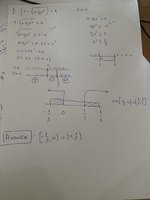[MATH]\frac{1}{x}(1-\sqrt{1-9x^2})<1 \hspace2ex[/MATH] (*)
A few observations first:
(A) For this to exist (as a real number) we need [MATH]1-9x^2≥0 \text{ and }x≠0[/MATH]Clearly [MATH]\rightarrow[/MATH][MATH]\boxed{ \hspace2ex x≠0 \text{ and } -\frac{1}{3}≤x≤\frac{1}{3}}\hspace2ex[/MATH] Restriction (1)
(B) Clearly[MATH](1-\sqrt{1-9x^2})\in (0,1][/MATH], so when [MATH]\boldsymbol{x}[/MATH]
is negative, then [MATH]\frac{1}{x}(1-\sqrt{1-9x^2})<1[/MATH]since [MATH]\frac{1}{x}<0[/MATH] and [MATH](1-\sqrt{1-9x^2})>0[/MATH]

[MATH] \text{Now find when} \hspace2ex \frac{1}{x}(1-\sqrt{1-9x^2})=1\\
1-x=\sqrt{1-9x^2}\\
\rightarrow x^2-2x+1=1-9x^2\\
\rightarrow 10x^2-2x=0\\
\rightarrow x(5x-1)=0\\
x=0 \text { or }x=\frac{1}{5}[/MATH](even though x≠0 in our question, we will consider the regions around 0, since the function [MATH]\frac{1}{x}(1-\sqrt{1-9x^2})[/MATH] is discontinuous).
Examining the regions, against the inequality (*); from B we know x<0 is included, and we find that [MATH]0<x<\frac{1}{5}[/MATH] is included.
[MATH]\therefore \boxed{ \hspace2ex x<\frac{1}{5}\hspace2ex}[/MATH] Restriction (2)
Putting these restrictions (1) and (2) together:
[MATH]-\frac{1}{3}≤x<\frac{1}{5}[/MATH], and [MATH]x≠0[/MATH]i.e. [MATH][-\frac{1}{3},0) \cup (0,\frac{1}{5})[/MATH]


